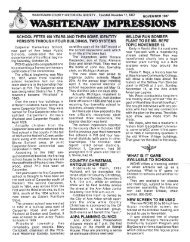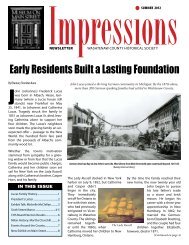Impressions - Washtenaw County Historical Society
Impressions - Washtenaw County Historical Society
Impressions - Washtenaw County Historical Society
You also want an ePaper? Increase the reach of your titles
YUMPU automatically turns print PDFs into web optimized ePapers that Google loves.
DOWN ON THE FARM<br />
. POLE SHEDS, AUTOMATIC FEEDERS REPLACE RED BARNS<br />
In India American agriculture ·<br />
has been held up as a paradigm of ·<br />
success. Villagers wondered at a<br />
place where one farmer may have<br />
5,000 chickens or 50 acres of land.<br />
But as you know, American<br />
farmers have gotten bigger and<br />
bigger and, at this time, we are in<br />
the process of agrarian transformation<br />
to a much larger corporate<br />
scale of agriculture in this country,<br />
Professor Hemalata Dandekar told.<br />
the March WCHS audience.<br />
Professor Dandekar and her<br />
students in the UM College of Architecture<br />
and Urban Plannig are<br />
researching where farming is now<br />
and what they can do about it if<br />
they don't like what is happening<br />
to farming, farm structures and<br />
small family farms.<br />
"Most of what I'm going to show '<br />
you (i n sl ides) really harks back to<br />
the earlier period in Michigan<br />
agricu Iture.<br />
"The typical farm with its outbuildings<br />
conveys an order and<br />
meaning that I think is disappearing<br />
from the Michigan countryside.<br />
" For 150 years the distinctive<br />
. and proud silhouette of the<br />
Michigan farmscape has reflected<br />
the generosity of the land and the<br />
industrious nature of the people<br />
who inhabited it.<br />
"Now, as you know, most of the<br />
aging farm structures are slowly<br />
sagging and toppling over on farmsteads<br />
throughout our county and<br />
state. Periodically, someone wants<br />
to buy the wood for lumber or<br />
siding.<br />
"Michigan farms and farmers<br />
have been the backbone of the<br />
state's earlier agrarian economy.<br />
They are now under duress. Time<br />
and progress appears to be<br />
diminishing their niche in society.<br />
"Taxes are going up. Crop prices<br />
are going down because of increased<br />
prouction and the spread<br />
of cities is making farmers' survival<br />
more problematic."<br />
Showing a picture of an unusual<br />
gothic barn on Island Lake Road,<br />
she noted that it had fallen down in<br />
recent months. It was built before<br />
the Civil War.<br />
"There's a character about a<br />
barn. Its a very immediate<br />
response to the dictum that form<br />
should follow function in architecture.<br />
The building represents what<br />
Barn pictures in this article and one in<br />
the March issue were drawn by Pro·<br />
fessor Oandekar.<br />
is grown on the land and what<br />
needs to be sheltered.<br />
"In our study of the Michigan<br />
farm we found there were about<br />
five types of farms and farm<br />
buildings to be traced over time:<br />
1. Subsistence cultivation,<br />
local markets (1818-1865),<br />
2. Scientific farming, regional<br />
markets open up (1865·1900),<br />
3. Specialized farming ,<br />
regional and national markets<br />
(1900·1945),<br />
4. Specialized farming, national<br />
and international marketS<br />
(1945-1975),<br />
5. Corporate farming<br />
(1975-present),<br />
"We've been disdaining and trying<br />
to ignore the corporate farming<br />
mode but I think we have to face<br />
the fact that it is on the horizon."<br />
"When you go from hand-hewn<br />
lumber to metal pole structures<br />
you see a 'distinct change in the<br />
farm building profile."<br />
A Waters Road farm illustrated a<br />
farm yard with old style barns of<br />
the 19th and early 20th century<br />
with added pole barns of the 1950s<br />
or so.<br />
"There is very little on the landscape<br />
from which we can take a<br />
. guess at forms of habitation of the<br />
original native settlers so we are<br />
starting our work from the early<br />
settlement period of about 1818<br />
when habitation of Michigan was<br />
facilitated by the survey of 1818.<br />
"In addition, the Erie Canal<br />
opening meant large populations<br />
could move into the southeast part<br />
of the state. The Chicago road<br />
(Michigan Avenue, US-12) en·<br />
couraged further settlement.<br />
"There was a land boom in 1836<br />
where about four million acres of<br />
land were sold.<br />
"I never understood why the<br />
roads were so straight in the country<br />
but the survey clearly articulates<br />
the way in which the land<br />
2<br />
came to be populated.<br />
"You had each township which<br />
was divided up into 36 sections.<br />
Each was one mile square and<br />
contained 640 acres. It is this pattern<br />
which makes it so easy to<br />
trace back ownership and land<br />
holding in this country.<br />
"We have been unable to find a<br />
log house from the first period of<br />
subsistence farming in this part of<br />
the state. If any of you know of any<br />
we would love to kow about it."<br />
She showed a log house built by<br />
John Young in Gratiot <strong>County</strong>. He<br />
went there in 1878 or so and<br />
bought 40 acres of land from a<br />
Detroit land speculator, she said.<br />
Young cleared the land and started<br />
-<br />
cultivating part of it.<br />
-- - . -<br />
"Young was Pennsylvania Dutch<br />
or German in origin. He began to<br />
try to make a living on the 40 acres<br />
with his wife, Sarah.<br />
"It was a subsistence farm. They<br />
would raise chickens. A little bit of<br />
cream would be sold. They had a<br />
couple of cows and most important<br />
was their horse.<br />
"At this time it was very common<br />
to share labor in harvesting, at<br />
barn-raisinqs and so on.<br />
"John Young probably built the<br />
log house with his friends, the<br />
Oltmans and the Jewells. These<br />
people moved together as a group<br />
and established a community in<br />
cooperation with each other.<br />
"The log house is a little different<br />
from the log cabin. The log<br />
cabin is seen as a very temporary<br />
structure after which the family<br />
would build a frame house and<br />
later a brick house or larger, more<br />
elaborate frame house.<br />
"The log house was often a permanent<br />
home for quite a few years.<br />
Young occupied this house until<br />
he died in the 1940s. Up to that<br />
point they didn't have any electricity<br />
or running water.<br />
"When I showed these pictures<br />
to a school of architecture in Bombay,<br />
they couldn't believe that<br />
there were people in the rich country<br />
of America who didn't have<br />
electricity until the 1950s.<br />
At the back of John Young's<br />
house, he added a frame kitchen<br />
and tool room. In addition he might<br />
have built a small barn and still<br />
later he might have built the<br />
gambrel-roof barn that still exists







